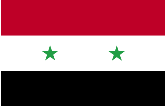|
Syria
|

|
Capital: Damascus
Population: 17,070,135
Brief History of Syria:
One of the oldest civilizations in the world, the Semitic Empire, was centered in the land of Syria. It covered much of the land from the Red Sea to Turkey. One of its major cities, Ebla, is estimated to have had a population of 260,000 people.
Due to Syria's location between the Middle East and Europe, the land was conquered by numerous empires and civilizations including the Canaanites, Phoenicians, Hebrews, Assyrians, Babylonians, Persians, Greeks, Romans, and Byzantines. Eventually the land came under the rule of the Ottoman Empire. Syria also holds a place in Christian history. It was on the road the Damascus that Paul was converted and set up the first Christian church in the Syrian city of Antioch.
After World War I, France gained control of Syria and gave it independence in 1946. However, the country experienced unrest with a series of military takeovers of the government. Today some stability has been reached, but there is constant tension with Israel over previous wars and the Golan Heights, the area between the two countries.
The Geography of Syria
Total Size: 185,180 square km
Size Comparison: slightly larger than North Dakota
Geographical Coordinates: 35 00 N, 38 00 E
World Region or Continent: Middle East
General Terrain: primarily semiarid and desert plateau; narrow coastal plain; mountains in west
Geographical Low Point: unnamed location near Lake Tiberias -200 m
Geographical High Point: Mount Hermon 2,814 m
Climate: mostly desert; hot, dry, sunny summers (June to August) and mild, rainy winters (December to February) along coast; cold weather with snow or sleet periodically in Damascus
Major cities: Aleppo 2.985 million; DAMASCUS (capital) 2.527 million; Hims 1.276 million; Hamah 854,000 (2009)
The People of Syria
Type of Government: republic under an authoritarian, military-dominated regime
Languages Spoken: Arabic (official); Kurdish, Armenian, Aramaic, Circassian widely understood; French, English somewhat understood
Independence: 17 April 1946 (from League of Nations mandate under French administration)
National Holiday: Independence Day, 17 April (1946)
Nationality: Syrian(s)
Religions: Sunni Muslim 74%, Alawite, Druze, and other Muslim sects 16%, Christian (various sects) 10%, Jewish (tiny communities in Damascus, Al Qamishli, and Aleppo)
National Symbol: hawk
National Anthem or Song: Humat ad-Diyar (Guardians of the Homeland)
Economy of Syria
Major Industries: petroleum, textiles, food processing, beverages, tobacco, phosphate rock mining
Agricultural Products: wheat, barley, cotton, lentils, chickpeas, olives, sugar beets; beef, mutton, eggs, poultry, milk
Natural Resources: petroleum, phosphates, chrome and manganese ores, asphalt, iron ore, rock salt, marble, gypsum, hydropower
Major Exports: crude oil, petroleum products, fruits and vegetables, cotton fiber, clothing, meat and live animals, wheat
Major Imports: machinery and transport equipment, electric power machinery, food and livestock, metal and metal products, chemicals and chemical products, plastics, yarn, paper
Currency: Syrian pound (SYP)
National GDP: $107,600,000,000
** Source for population (2012 est.) and GDP (2011 est.) is CIA World Factbook.
Back to Geography Home Page
